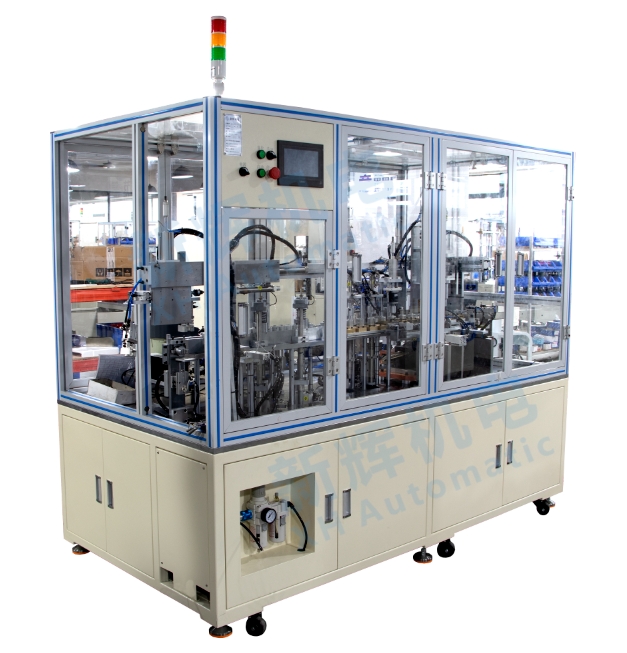What spare parts are needed for DC brush motor motor fully automatic pressure bearing magnetizing machine and how to set up guarantee stock?
I. Spare parts list
1、Mechanical parts
Transmission belt (chain) and gears: Transmission belt (chain) is the key part of power transmission, and is prone to wear, aging and other problems. Gear in long-term operation will also have the possibility of tooth wear, broken teeth.
Press head and jig: In the process of pressing bearings, the press head and jig will be worn and deformed due to frequent contact and pressure, affecting the precision of pressing.
Locating pins and locating blocks: used to ensure the correct position of parts in the equipment, long time use may be worn, resulting in the loss of positioning accuracy.
Bearings and seals: There are several rotating parts in the equipment that need bearings to support them, while seals are used to prevent lubricant leakage and dust entry, both of which are easily damaged.

2. Electrical components
Motor brushes and commutator: for DC brush motors, the brushes are wearing parts and will wear out with long-term use, while the commutator may also experience surface wear and ablation.
Sensors: including position sensors, pressure sensors, etc. They may be damaged by environmental factors (e.g. dust, oil, moisture), mechanical collisions or electrical failures.
Relays and contactors: In electrical control systems, these components are frequently switched on and off and the contacts are prone to wear, oxidation or sticking.
Fuses and Circuit Breakers: As circuit protection devices, fuses will blow during overloads or short circuits, and circuit breakers will trip, requiring prompt replacement to restore the circuit.
Control circuit boards and chips: Although these parts are relatively durable, damage may result from long-term use, overheating, static electricity and other factors.
3. Other components (if applicable)
Hydraulic system components (e.g., seals, tubing): For pressure bearings or magnetizing mechanisms that are hydraulically driven, the seals of the hydraulic system are susceptible to deterioration and damage, and the tubing may be ruptured and leaking.
Pneumatic system components (e.g., cylinder seals, air tubes): In pneumatic equipment, worn cylinder seals can lead to insufficient air pressure, and broken air tubes can affect the normal operation of the air circuit.
Second, to protect the inventory setup method
1、Determine the key spare parts
Failure frequency analysis: collect the historical maintenance records of the equipment, statistics on the number of failures and frequency of each spare part. For example, by looking at the past year's maintenance records, to determine how many times the drive belt (chain) replacement, sensor failure a few times, etc., the high failure frequency of spare parts as key spare parts.
Maintenance time and impact assessment: Consider the impact on equipment maintenance time and production when a spare part is damaged. If a spare part is damaged, the equipment needs to be shut down for a long time to wait for spare parts replacement, or will lead to a large number of product quality problems, then even if its failure frequency is not high, it should be regarded as a key spare part. For example, some special specifications of the motor, if you need to purchase from foreign suppliers, the procurement cycle is long, then you need to focus on its guaranteed inventory.
2、Calculate the quantity of guaranteed stock
Mean Time to Repair (MTTR) and Mean Time Between Failures (MTBF) Calculation: Calculate the MTTR and MTBF of each spare part based on historical data MTTR refers to the average time required from the occurrence of an equipment failure to the resumption of normal operation, and MTBF refers to the average time interval between two adjacent failures. For example, a sensor has an MTBF of 1000 hours and an MTTR of 2 hours. Use the formula: Guaranteed Inventory Quantity = (MTTR / MTBF) x Estimated Usage Quantity. Assuming that the equipment is expected to use 10 of these sensors in the next year (assuming 2000 hours of operation), then the guaranteed stock level = (2 / 1000) x 10 = 0.02 (rounded up to the nearest 1).
Consider the uncertainty factors: in the actual calculation, to consider some uncertainty factors, such as changes in the environment of the use of equipment, fluctuations in the quality of spare parts, changes in the delivery date of the supplier. Can be appropriate to increase the number of guaranteed stock, generally can be increased by 10% -30% of the margin. For example, the number of guaranteed stock of the above sensors can be considered to increase to 1 - 2.
3、Inventory management
Inventory monitoring and early warning: establish an inventory monitoring system to track the inventory quantity of spare parts in real time. When the stock quantity is lower than the lower limit of guaranteed stock (e.g. 50% of the guaranteed stock quantity), the system automatically issues an early warning to remind the purchasing department to replenish the stock in time.
Regular Inventory and Update: Regular inventory of spare parts inventory is conducted to ensure the accuracy of the inventory quantity. At the same time, according to the replacement of equipment, spare parts quality feedback, failure frequency changes, etc., timely update the type and quantity of guaranteed inventory. For example, if the equipment is technologically upgraded and certain spare parts are no longer used, or new spare parts are added to the equipment maintenance system, the inventory should be adjusted accordingly.
Supplier management: Establish long-term relationships with reliable spare parts suppliers to ensure the quality and timeliness of spare parts supply. Understand the supplier's lead time, minimum order quantity, price fluctuations, etc., in order to make reasonable decisions when setting up guaranteed inventory and purchasing spare parts. For example, choose suppliers that offer short lead times and stable prices, and for some critical spare parts, sign an emergency supply agreement with the supplier to ensure quick access to spare parts in the event of sudden equipment failure.
※ If you need any help, please contact Xinhui's technical specialists through the page chat tool for assistance.







